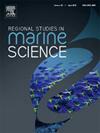Comparison of efficiency of spectral (NDWI) and SAR (GRD) method in shoreline detection: A novel method of integrating GRD and SLC products of sentinel-1 satellite
IF 2.1
4区 环境科学与生态学
Q3 ECOLOGY
引用次数: 0
Abstract
In the context of shoreline change studies for management and development purposes, it is essential to utilize historical shoreline positions. Today, various satellite methods and images are utilized; for instance, the capabilities of contemporary spectral images are well established. However, given the efficiency of Synthetic Aperture Radar (SAR) images in providing earth observations under all weather conditions, their use for identifying shoreline positions is increasingly being developed. This study presents a comparative analysis of shoreline extraction using the Ground Range Detected (GRD) and GRD-SLC (Single Look Complex) methods, alongside the spectral method as a reference. The GRD-SLC method significantly improved accuracy, particularly in estuarine areas, reducing median discrepancies from 378.0 m ( ± 247.7) with the GRD method to 16.0 m ( ± 26.6) for this type of shores. For steep rocky shores, the discrepancy decreased from 22.1 m ( ± 18.4) to 8.5 m ( ± 10.1). Conversely, the GRD method performed better for dune-backed, wide sandy, and rocky shores. Overall, the GRD-SLC method yielded a discrepancy of less than 50 m in key areas like omega-shaped beaches and cliffs, with its best performance observed in low-elevation regions (<10 m). The findings emphasize the GRD-SLC method’s suitability for diverse coastal environments. Despite the limitations of the GRD method, its all-weather SAR imagery capability proves effective on a regional scale. This study highlights the need for further algorithmic advancements in SAR-based shoreline monitoring to enhance accuracy across varying coastal terrains.
在为管理和发展目的进行海岸线变化研究时,必须利用历史海岸线位置。如今,可以利用各种卫星方法和图像;例如,当代光谱图像的能力已得到公认。不过,鉴于合成孔径雷达 (SAR) 图像在全天候条件下提供地球观测数据的效率,越来越多地将其用于确定海岸线位置。本研究对使用地面范围探测(GRD)和 GRD-SLC(单望复合)方法提取海岸线进行了比较分析,并以光谱方法作为参考。GRD-SLC 方法大大提高了精确度,尤其是在河口地区,将这类海岸的中位偏差从 GRD 方法的 378.0 米(± 247.7)减少到 16.0 米(± 26.6)。对于陡峭的岩石海岸,差异从 22.1 米(± 18.4)减小到 8.5 米(± 10.1)。相反,对于沙丘背、宽阔的沙质和岩石海岸,GRD 方法的效果更好。总体而言,在欧米茄形海滩和悬崖等关键区域,GRD-SLC 方法的差异小于 50 米,在低海拔区域(<10 米)表现最佳。研究结果表明,GRD-SLC 方法适用于多种沿海环境。尽管 GRD 方法存在局限性,但其全天候合成孔径雷达成像能力在区域范围内证明是有效的。这项研究强调,需要进一步改进基于合成孔径雷达的海岸线监测算法,以提高不同海岸地形的监测精度。
本文章由计算机程序翻译,如有差异,请以英文原文为准。
求助全文
约1分钟内获得全文
求助全文
来源期刊

Regional Studies in Marine Science
Agricultural and Biological Sciences-Ecology, Evolution, Behavior and Systematics
CiteScore
3.90
自引率
4.80%
发文量
336
审稿时长
69 days
期刊介绍:
REGIONAL STUDIES IN MARINE SCIENCE will publish scientifically sound papers on regional aspects of maritime and marine resources in estuaries, coastal zones, continental shelf, the seas and oceans.
 求助内容:
求助内容: 应助结果提醒方式:
应助结果提醒方式:


